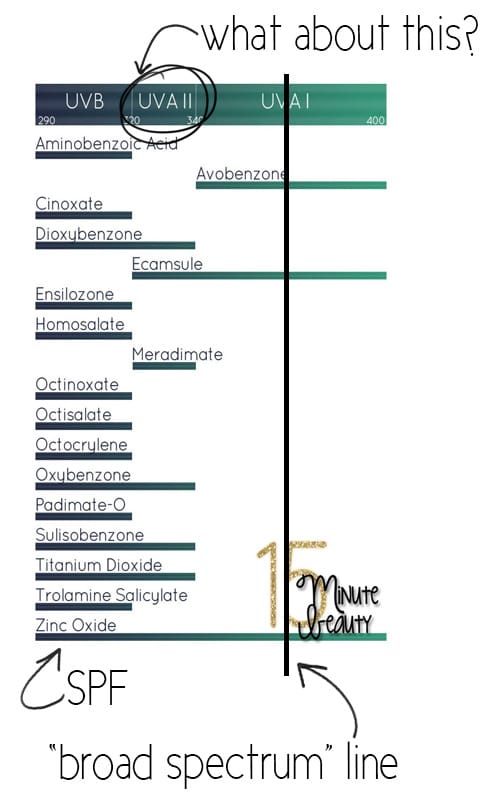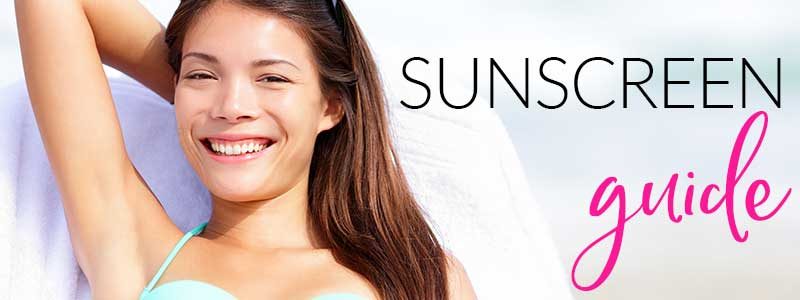If you have read many of my sunscreen posts, you’ve likely noticed that I make a big distinction between broad spectrum and full spectrum sunscreen. But, you can’t go to the store and look for “full spectrum sunscreen”. Because I made that term up.**
Why full spectrum rather than broad spectrum UV coverage? When the FDA changed sunscreen labels, they cracked down on those companies that claim their product is broad spectrum, which didn’t actually mean anything.
Now, in order to claim a product is broad spectrum, there are criteria that need to be met. First, a product’s SPF is tested, for which only UVB coverage is measured. Next, based upon the SPF, a certain amount of coverage is needed at 370 nm, in the UVA I range. This sounds great, because it does mean that there’s some UVA coverage in addition to the UVB coverage. But, it also means that a product can be labelled as broad spectrum coverage without having any UVA II coverage. And there are quite a few products that are just like that!
The good news is that you can achieve full spectrum UV coverage if you check the ingredient lists. The bad news is that you need to check the ingredient list to find a full spectrum sunscreen.
Here are a few posts listing full spectrum sunscreens, all updated in 2018!
Full Spectrum Body Sunscreens
8 Full Spectrum Facial Sunscreens
Pregnancy Safe Full Spectrum Sunscreens
Pregnancy Safe Full Spectrum Facial Sunscreens, BB & CC Creams
** I did totally make this term up. If you’ve seen it anywhere else, I doubt others used it after me, probably I coincidentally thought of it at the same time as a much smart derm. Though for the record I first mentioned it (in a now-defunct post) in 2011, with the last major FDA change in Sunscreen Labelling.



 I’m a doctor, a mommy and a bit of a beauty addict. If you let me, I can take 2 hours to get ready in the morning. Really. I'm on a quest for faster beauty that works!
I’m a doctor, a mommy and a bit of a beauty addict. If you let me, I can take 2 hours to get ready in the morning. Really. I'm on a quest for faster beauty that works!
Could you please list the ingredients that are in a full spectrum sunscreen? Thanks.
There are many combinations that would make full spectrum. You need to look at the ingredients and ensure you have coverage across the spectrum.
Hi!
I would like to know if these sunscreens are pregnancy safe:
PanOxyl AM Oil Control Moisturizer
Active Ingredients: Zinc Oxide 17%
Inactive Ingredients: Bisabolol, Butyloctyl Salicylate, C12-15 Alkyl Benzoate, Caffeine, Caprylyl Glycol, Ethylhexylglycerin, Glycerin, 1,2-Hexanediol, Hydroxyacetophenone, Hydroxyethyl Acrylate/Sodium Acryloyldimethyl Taurate Copolymer, Phenethyl Alcohol, Polyglyceryl-4 Laurate/Succinate, Polyhydroxystearic Acid, Polymethylsilsesquioxane, Polysorbate 60, Puried Water, Sodium Hyaluronate, Sodium Hydroxide, Sorbitan Isostearate, Sorbitan Monostearate, Tapioca Starch, Tetrasodium Glutamate Diacetate, Tocopheryl Acetate (Vitamin E), Triethoxycaprylylsilane, Xanthan Gum
Avene Tinted Mineral Sunscreen Fluid Spf 50
Active Ingredients: Titanium Dioxide (11.4%), Zinc Oxide (14.6%)
Inactive Ingredients: Water, Coco-Caprylate/Caprate, Isopropyl Palmitate, Isocetyl Stearoyl Stearate, Isodecyl Neopentanoate, Isododecane, Isohexadecane, PTFE, Triethylhexanoin, Dicaprylyl Ether, PEG-30 Dipolyhydroxystearate, Alumina, Stearic Acid, Caprylyl Glycol, PEG-45/Dodecyl Glycol Copolymer, Silica, Benzoic Acid, Caprylic/Capric Triglyceride, Disodium EDTA, Disteardimonium Hectorite, Glyceryl Behenate, Glyceryl Dibehenate, Helianthus Annuus (Sunflower) Seed Oil, Pentaerythrityl Tetra-Di-T-Butyl Hydroxyhydrocinnamate, Polyamide-3, Sodium Chloride, Tocopherol, Tocopheryl Glucoside, Tribehenin, Triethoxycaprylylsilane, Iron Oxide, Mica, Titanium Dioxide
Thank you!!
#1 has salicylate so is ok for nursing but not pregnancy
#2 is ok for pregnancy and nursing
Hi doc, what is your opinion on safety of Tinosorb in Sunscreen during pregnancy? I’ve read a research abstract that concluded Tinosorb is not a hormone disruptor, do you agree? Here is the abstract:
Abstract
The presence of structurally diverse chemicals as contaminants in the environment has led to concerns regarding their possible endocrine disturbing effects. Recently, some ultraviolet absorbing components of sunscreen preparations have given positive responses in assays monitoring estrogen-like activity both in vitro and in vivo. Consequently, two recently developed sunscreen components, Tinosorb M-active and Tinosorb S, were evaluated using the in vitro estrogen and androgen receptor competitive binding assays. Neither compound gave a positive response in either of the assays, consistent with the large molecular dimensions of each chemical disfavoring binding to the hormone receptors. Both of the chemicals were inactive in immature rat uterotrophic assays conducted using the subcutaneous route of administration. It is concluded that neither of these agents possess intrinsic estrogenic/antiestrogenic or androgenic/antiandrogenic activity. The several positive control chemicals evaluated gave the expected positive responses in the assays used.
It’s not thought to be a hormone disruptor (I think only oxybenzone is really felt to do that currently) but all chemical sunscreens are highly absorbed and many physicians recommend avoidance in pregnancy due to that, not necessarily just for the hormone disruption issues. Note, Oxybenzone was also linked to increased incidence of Hirshprung’s Disease, which is 100% not related to any endocrine issues.